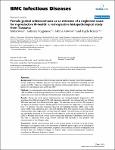Female genital schistosomiasis as an evidence of a neglected cause for reproductive ill-health: a retrospective histopathological study from Tanzania
Swai, Britta
Poggensee, Gabriele
Mtweve, Sabina
Krantz, Ingela
Background: Schistosomiasis affects the reproductive health of women. Described sequelae are ectopic pregnancy, infertility, abortion, and cervical lesions and symptoms mimicking cervical cancer and STIs. There are indications that cervical schistosomiasis lesions could become co-factors for viral infection such as HIV and HPV. Methods: In a retrospective descriptive histopathological study clinical specimens sent between 1999 and 2005 to the pathology department of a consultant hospital in Tanzania were reviewed to analyse the occurrence and features of schistosomiasis in female genital organs. Results: During the study period, schistosomiasis was histopathologically diagnosed in 423 specimens from different organs (0.7% of all specimens examined in the study period), out of those 40% were specimens from female and male organs. The specimens were sent from 24 hospitals in 13 regions of mainland Tanzania. Female genital schistosomiasis was diagnosed in 125 specimens from 111 patients. The main symptoms reported were bleeding disorders (48%), ulcer (17%), tumor (20%), lower abdominal pain (11%) and infertility (7%). The majority of cases with genital schistosomiasis were diagnosed in cervical tissue (71 cases). The confirmation of cervical cancer was specifically requested for 53 women, but the diagnosis could only be verified for 13 patients (25%), in 40 cases only severe cervical schistosomiasis was diagnosed. Vulval/labial schistosomiasis was seen in specimens from young women. Infertility was reported in four patients with schistosomiasis of the Fallopian tubes. Conclusion: Genital schistosomiasis adds to the disease burden of women in all age groups. Pathological consequences due to the involvement of different genital organs can be damaging for the affected women. Clinical unawareness of genital schistosomiasis can lead to misdiagnosis and therefore false and ineffective therapy. In endemic areas cervical schistosomiasis should be considered as differential diagnosis of cancer.
Dateien zu dieser Publikation
Keine Lizenzangabe
Verwandte Publikationen
Anzeige der Publikationen mit ähnlichem Titel, Autor, Urheber und Thema.
-
2013-06-06ZeitschriftenartikelTravel-associated Legionnaires’ disease in Europe, 2010 Jong, B. de; Hallström, L. Payne; Robesyn, E.; Ursut, D.; Zucs, PhillipIn 2010, the European surveillance network for travel-associated Legionnaires’ disease (ELDSNet, previously EWGLINET) received reports of 864 cases of travel-associated Legionnaires’ disease, of whom 24 were reported to ...
-
2013-12-17ZeitschriftenartikelCo–Residence between Males and Their Mothers and Grandmothers Is More Frequent in Bonobos Than Chimpanzees Schubert, Grit; Vigilant, Linda; Boesch, Christophe; Klenke, Reinhard; Langergraber, Kevin; Mundry, Roger; Surbeck, Martin; Hohmann, GottfriedIn long–lived social mammals such as primates, individuals can benefit from social bonds with close kin, including their mothers. In the patrilocal chimpanzee (Pan troglodytes spp.) and bonobo (Pan paniscus), sexually ...
-
2013-03-21ZeitschriftenartikelEpidemiology of norovirus gastroenteritis in Germany 2001-2009: eight seasons of routine surveillance Bernard, Helen; Höhne, Marina; Niendorf, Sandra; Altmann, Doris; Stark, KlausWe analysed data on laboratory or epidemiologically confirmed cases (n = 856,539) and on outbreaks (n = 31,644) notified during week 31 (2001) to week 30 (2009), and performed molecular typing of specimens from 665 outbreaks. ...

